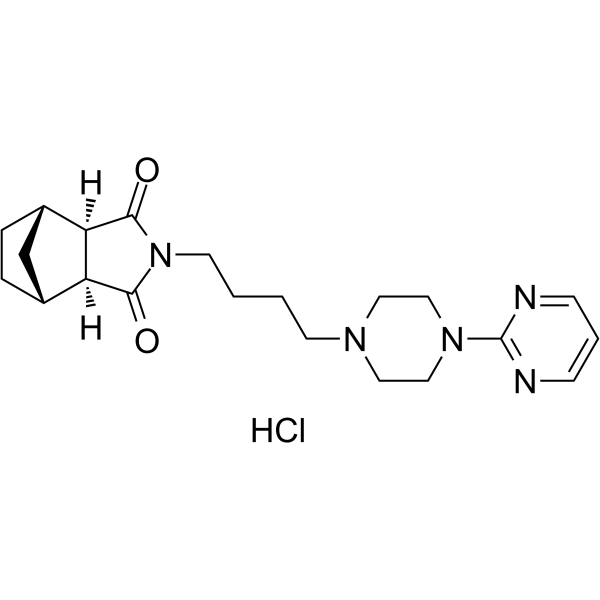| Description |
Tandospirone (SM-3997) hydrochloride is a potent and selective 5-HT1A receptor partial agonist, with a Ki of 27 nM. Tandospirone hydrochloride has anxiolytic and antidepressant activities. Tandospirone hydrochloride can be used for the research of the central nervous system disorders and the underlying mechanisms[1][2][3].
|
| Related Catalog |
|
| Target |
5-HT1A Receptor:27 nM (Ki)
|
| In Vitro |
Tandospirone (SM-3997) hydrochloride is approximately two to three orders of magnitude less potent at 5-HT2, 5-HT1C, α1-adrenergic, α2-adrenergic and dopamine D1 and D2 receptors (Ki values ranging from 1300 to 41000 nM) than 5-HT1A[1]. Tandospirone hydrochloride is essentially inactive at 5-HT1B receptors; 5-HT uptake sites; beta-adrenergic, muscarinic cholinergic, and benzodiazepine receptors[1]. Tandospirone hydrochloride activates postsynaptic 5-HT1A receptor coupled with G-protein (Gi/o), resulting in inhibition of protein kinase A (PKA)-mediated protein phosphorylation and neuronal activity[1].
|
| In Vivo |
Tandospirone (SM-3997) hydrochloride (10-80 mg/kg; i.p.) inhibits freezing behavior in the conditioned fear stress-induced freezing behavior rat model[3]. Tandospirone hydrochloride exhibits the anxiolytic effect dependent on the plasma concentration of at 0.5 hours but not 4 hours[3]. Animal Model: Seven-week-old male Sprague-Dawley rats (260-300 g), conditioned fear stress-induced freezing behavior rat model[3] Dosage: 10 mg/kg, 20 mg/kg, 40 mg/kg, 80 mg/kg Administration: Intraperitoneal injection Result: Inhibited freezing behavior in a dose-dependent manner.
|
| References |
[1]. Hamik A, et al. Analysis of tandospirone (SM-3997) interactions with neurotransmitter receptor binding sites. Biol Psychiatry. 1990 Jul 15;28(2):99-109. [2]. Xuefei Huang, et al. Role of tandospirone, a 5-HT1A receptor partial agonist, in the treatment of central nervous system disorders and the underlying mechanisms. Oncotarget. 2017 Nov 24; 8(60): 102705–102720. [3]. Kyoko Nishitsuji, et al. The pharmacokinetics and pharmacodynamics of tandospirone in rats exposed to conditioned fear stress. Eur Neuropsychopharmacol. 2006 Jul;16(5):376-82.
|
